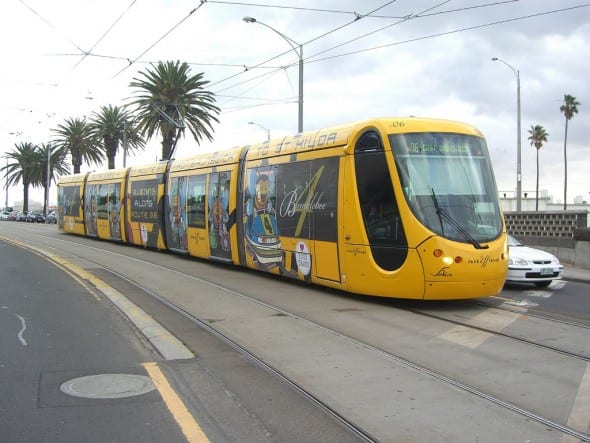A ground-breaking proposal to power Melbourne’s entire network of electric trams with locally generated solar energy could be underway within the year, pending the approval of the Victorian Labor government.
The company behind the bid, the Australian Solar Group, told RenewEconomy the fully-financed $70 million project – which would involve the construction of two 20MW single-axis tracking solar plants – was “literally” ready to go on one of the sites, but was awaiting final government approval, which it had failed to receive under the previous Coalition government.
This final go-ahead was needed to pave the way for a crucial Power Purchase Agreement with the government-owned Public Transport Victoria (PTV), which pays Yarra Trams electricity bills.
The two solar farms would generate 80 gigawatt-hours of electricity a year, about the same amount used by Melbourne’s tram network – which would be a big chunk of supply lost to the state’s coal-fired generators.

Whether this was factored into the Baillieu/Napthine government’s decision making process is unclear, but a correspondence from the former transport minister, cited by Fairfax Newspapers on Tuesday, suggests some loyalty to the state’s energy incumbents.
The Age reports that State Coalition Minister Terry Mulder sent a letter to the city council last October saying the government-owned PTV was interested in the project, but that it had to be “measured against the availability of brown coal and natural gas that for many years have given Victoria a relatively cheap source of energy.”
But Dave Holland, a co-founder of the Australia Solar Group, told RenewEconomy there was no suggestion that fossil fuel favouritism would be a factor under the current Andrews government.
“We haven’t felt it to date,” he said. “Based on what the new government are saying, I don’t expect that to be an issue… that’s certainly not the feeling that we get.”
More importantly, Holland says the renewable solar power generated by the two 20MW farms could match coal power on cost.
“It was a condition given to us as part of the mission that we couldn’t increase the cost of commuting,” he told RE. “We modelled historical contracted and future prices … and (the result of) this has been one of the driving forces behind the project.”
Australian Solar says the two farms would span across 80 hectares on sites in Swan Hill and Mildura – the latter being were Holland’s former company, Solar Systems, was building a large solar project when it went into financial collapse in 2009.
Permit processes are still underway for the Mildura site, but the Swan Hill site is good to go, says Holland, with planning and grid connection approvals secured.
“The first site is ready to go, we could literally start site works immediately… within the week,” he told RE, adding that the company expected the works on each solar farm to take around six months to complete.
Holland said the company had already spent around $3 million on the project to date, and would spend a further $70 million – which it had already secured – if it got the go-ahead.
He told RenewEconomy that the equity component of the finance had been secured through Lighthouse Infrastructure. He was not able to discuss the project’s debt arrangements, however.
Holland also confirmed that the suppliers of the technology for the single-axis PV tracking plant had been decided, but were currently the subject of a confidentiality clause.








